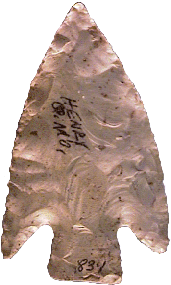

Point Type: WADE
Also See: Apple Creek, Buck Creek
Barbed, Crooked Creek, Cypress Stemmed, Glacial
Kame Stemmed, Hamilton, Kampsville Barbed, Lone Tree, Mehlville
, Mo-Pac, Motley, Smithsonia,
Springly, Table Rock
Location: Southeastern United States especially Alabama & Tennessee
Associated Dates:
4500 - 3500 B.P. - Late Archaic - Early Woodland
Morphology: Stemmed
General Description: The Wade is medium sized, barbed shouldered, straight stemmed dart point. It has deep basal notches with long inversely tapered barbs. The cross section is biconvex or flattened. The shoulders are barbed. The barbs are often as long as the stem giving the appearance of a basal notched point. The blade edges are typically excurvate but can be straight. The distal tip is acute. The stem is usually straight but may be slightly expanding. The side edges of the stem are usually straight and the basal edge may be straight or slightly concave. The stem is thinned and is usually slightly ground.
Deep to shallow random flaking was used on the blade and stem faces. Short and fairly deep flakes were removed in the retouching process of the blade edges and the stem.
The Wade point is usually found in the Tennessee River Valley drainage in northern Alabama and Tennessee. The maximum extent of the distribution for the type is not known however a few specimens of the type have been found in the Ohio River Valley in Indiana as well as in Missouri. The point has been found in pre ceramic contexts in Shell Middens as well as in Early Woodland contexts associated with pottery. The Wade may be related to the Buck Creek Barbed and the Kampsville Barbed types which are found in west-central Illinois. The Wade point has been found with Motley points in caches.
The size of the Wade point ranges from 39 to 80 mm in length. The average size for the point is in the 40 mm range. The width ranges from 27 to 45 mm with the average being 34 mm. The maximum thickness range is between 5 and 9 mm with the average being 7 mm. The stem length is between 9 and 12 mm with the average being 11 mm. Stem width is between 10 and 16 mm with the average being 14 mm. The Wade point was named by James W. Cambron and David C. Hulse in 1960 for points they found at several sites near Wade Landing on the Tennessee River, Limestone County, Alabama.
About the Point Above: The very large Wade point pictured at the top of this page was found in Henry County Missouri. It is made from a dull white chert material which has numerous small dark spots and rust colored inclusions. Overall the point measures 75 mm in length, 44 mm wide at the barbs and 8 mm at its thickest point, which is just above the stem at mid blade. The stem edges and base are slightly ground and the stem is thinned to only 4.5 mm in thickness. The stem measures 19 mm wide (which is beyond the typical metric data for the type) at the basal end and is 15 mm long. The typical blade thickness is only 6 mm. The blade edge length is 76 mm on each edge. The blade is highly patinated and the words "Henry Co. MO" and "834" are written on the artifact in black ink. Catalog Number 129-81-L
References: Baker, Cambron & Hulse, Dragoo (c, f), Justice(1), Overstreet, Perino (1)
© Copyright 1997 - 2009 LITHICS-Net WWW.LITHICSNET.COM
Use Your Browser's BACK Button to Return to the LITHICS-Net Index.